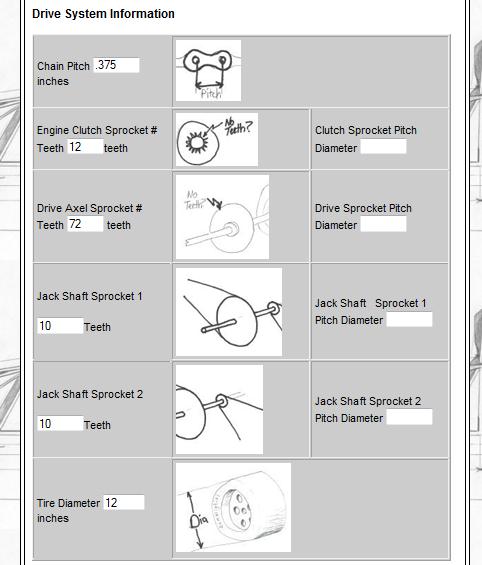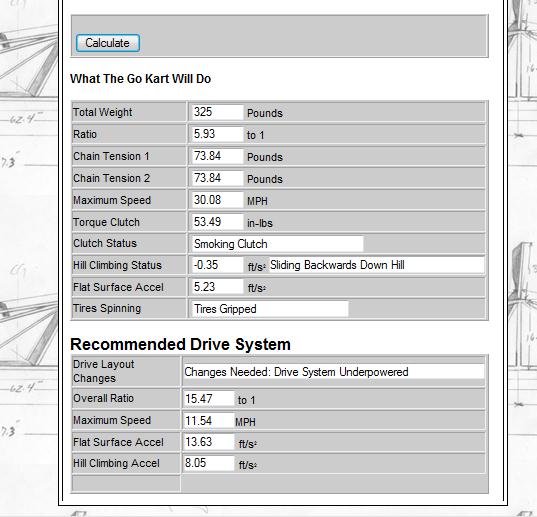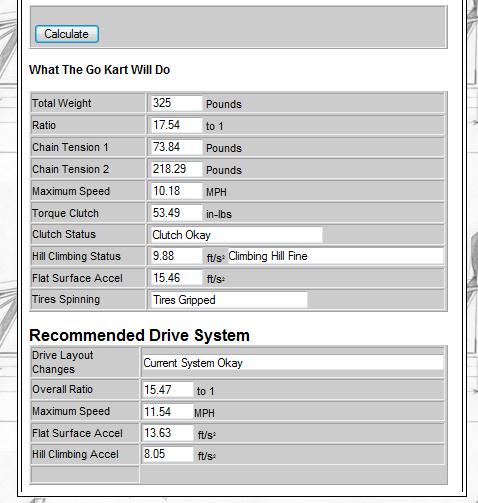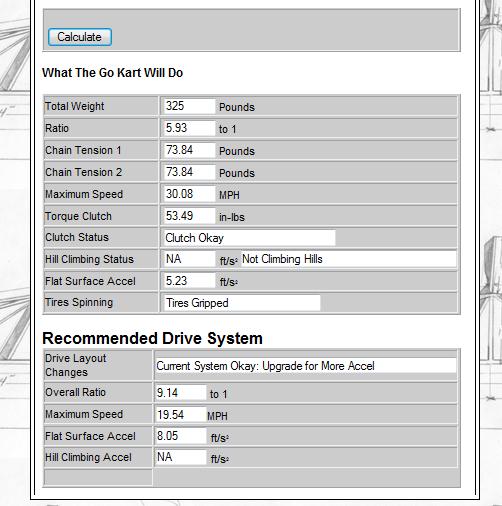The Go Kart Drive Line Program
(This is an exerpt from the Go Kart Building 203 Book on the Drive Line Program)

Inputs section for the program. The Frame Weight, Person Weight, Engine Hp, Max Engine RPM, Rated Rpm and Clutch Engagement RPM
After having gone through all these calculations you may be anxious to get some answers quicker. The go kart program will help with that. Though it is not as exhaustive as the graphs and formulas it will get you answers at the click of a mouse.
The go kart program is broken down into the following areas:
– Go Kart Specifications
– Go Kart Engine
– Go Kart Clutch
– Go Kart Drive Line
– Go Kart Calculation
– Go Kart Results
– Go Kart Recommendation
The go kart specifications section is gathering information about the weight of the go kart and the weight of the person.
The go kart engine section is gather information about the engine horsepower, the horsepower rating rpm, maximum rpm and the clutch engagement rpm. The default setting for the hp is a 5hp@3600 rpms. The torque engagement rpm is 2200 rpm, which has been validated by in house testing.

Go Kart Drive Line System Info, starting with chain pitch, clutch sprocket diameter, Jack Shaft 1 Sprocket, Jackshaft 2 Sprocket, Final Drive Sprocket and Tire Diameter
The Drive Line Section
The drive line section is designed to take into account a jack shaft system. The program is by default set up so the Jack Shaft system is ignored, or it is neutral in the calculation by making the input and output sprockets the same size.
The drive section is composed first of the chain pitch (this affects the diameters of the sprockets), second the clutch drive sprocket, then the J1 (or Jackshaft 1 sprocket) , the J2 (or Jackshaft 2 sprocket which is typically a very small sprocket) and finally the Tire Diameter.

Calculations Section: Starting with Total Weight, Ratio, Chain Tension of Jackshaft 1 and Jackshaft 2, Max MPH, Clutch Torque, Clutch Status, Hill Climbing Status, Accelleration Up Hill, Accelleration Flat and whether the tires spun or gripped.
The Calculations Section
The calculations section shows the essential data needed to determine if the drive system is going to work or not.
First the total weight is important for go kart performance; the program totals that up for you. Second the OVERALL ratio is calculated, along with the chain tensions on both the jackshaft systems. These are labeled Tension1 and Tension 2. This data is needed to determine if the chain is going to snap or not (unfortunately the program does not tell you if you chain is overstressed or not…yet)
Third the program also
calculates the maximum MPH of the gokart based on maximum engine rpms. Fourth it calculates the clutch status and clutch torque. The Hill climbing status is important for go karters who are seeking to go off road.
At the bottom of the page the program gives recommendations. Because the hill angle was set at 10 degrees the program is recommending changes to get the go kart to climb the hill. The overall ratio is key to this recommendation.
As you can see this program run was not successful for climbing hills. The go kart in fact would go backwards down the hill, which is just the opposite of what we are trying to achieve.
Upgrading The Drive System To Handle Hills: How It’s Done
In order to get the go kart to climb the hill, the overall ratio needs to be updated.
To get that to happen, the large sprocket on the jackshaft needs to be made larger. So the value of 30 teeth was put into the program and as you can see the overall ratio was upgraded and the program settled down told you that you the go kart can climb hills now!

Jack Shaft Inputs. Jack Shaft 1 is the larger driven sprocket, Jackshaft 2 is the driven smaller sprocket

Recalculated to climb hills

Hill Angle Option can be changed to zero degrees for Flat Surface Calcs
Flat Landers Go Kart Calculations
Not all of us want to climb hills, so the program has the option of changing the hill angle value to 0 (zero) degrees.
(The program by default is set up for climbing hills at 10 degrees)
When the angle is changed to Zero, the program will calculate the performance of the go kart assuming no hill.
The recommendation section will give a drive system that is designed around the optimum accelleration of ¼ g or 8 ft/s2 .

Flat Surface Calculation


